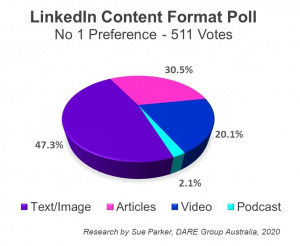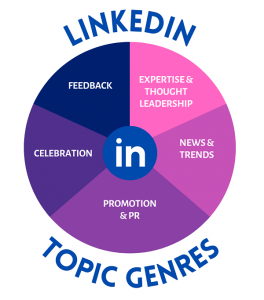The juice on LinkedIn content traction
Share

Sue Parker is back with the juice on LinkedIn. This time she explores how to make content that goes the distance and gets real traction.
As everyone in the marketing world knows great content is king, queen and everything between on LinkedIn. Whether you have a LinkedIn content strategy for your own agency or that of your clients you want a ‘ROE’ (return on effort).
Many marketers are throwing their hands in the air in frustration at the never ending stream of changes, algorithm fluctuations and divergent opinions on the how, what and when for traction.
Content goals
Content on LinkedIn that engages, educates and encourages conversations is at the core of the platform’s brand promise to build networks, raise visibility and inspire conversations. Traction derives from relevant networks, quality content, organic reach and engagement. This applies to every marketer and their client.
But there is no silver bullet for quick success. It’s essential to stay away from dodgy marketing services that are against LinkedIn’s User Agreement. The key elements are persistence, consistency and creative strategies backed by the latest research and tools.
Get these elements right and success is a shorter road. Get them wrong and organic reach and success can be compromised. And while high engagement metrics are valuable (likes and comments) they don’t paint a full picture of success as large numbers of members lurk and read without engaging.
The length of time spent on content is an important algorithm trigger to distribute content further. This is the algorithm process filtering system known as Dwell Time which analyses value and a fairer weightage and feed ranking of content.
Topic genres
Mixing up content topics is important for a healthy and vibrant content strategy on both personal profiles and company pages. Like a good diet a variety is needed but some genres in moderation and some in hearty abundance.
- Expertise and thought leadership: Insights, opinion pieces, education, new ideas
- News and trends: Current affairs, industry news, statistics, insights, commentary
- Promotion/PR: Announcements, events, updates, hiring, promoting services
- Celebration: Staff updates, awards, stories of success, fun stuff
- Feedback: Calls for industry feedback and advice, questions
Members content preferences
We are both content consumers and creators. Factoring in LinkedIn’s brand positioning and members predilections is vital. It’s illogical to assume that 100 percent of any industry, gender or age demographic will favour a specific format. 
This was evident from the LinkedIn Poll I ran in 2020 asking ‘what member’s content format preference was – as a consumer’. Respondents were mid to senior professionals and business owners from most professional sectors. Ages ranged from 35 to 55, with 285 men and 226 women. Similar global polls since all deliver similar findings.
Top 8 juicy tips
- Posting more than once a day significantly decreases reach on subsequent posts. Ideally no more than 5 pieces of content a week from your personal profile. Company pages posts and articles are in addition.
- Hashtags are essential for reach and topic categorisation. No more than three or four. Hashtag stuffing leads to SPAM classification and looks desperate and unfocussed. I have researched the Top 400 with followers over 60K with many surprises what got in and didn’t meet the metric.
- Minimise tagging people in posts and only when they have direct relevance to the content. Excessive tagging can create a SPAM trigger if people do not engage. Best to tag in comments.
- Scheduling tools are not advised as they have been proven to reduce distribution. Most software don’t transfer hashtag links.
- Keep growing a quality network of relevant connections to increase eyeballs.
- Don’t use Unicode or fancy bold fonts to try and stand out. They can be garbled and unreadable on many Android devices.
- Invest time and genuine engagement in your networks and ideal target markets content. This will trigger the algorithm to share more of your content and tailor your unique AI and reciprocity reach.
- Be realistic – don’t expect every piece of content will be a hit. Some posts will bomb and others fly. Measure, test, be brave and have some fun!
Sue Parker is the owner of Dare Group Australia a LinkedIn, careers and personal branding consultancy.
Photo by davisuko on Unsplash.
















